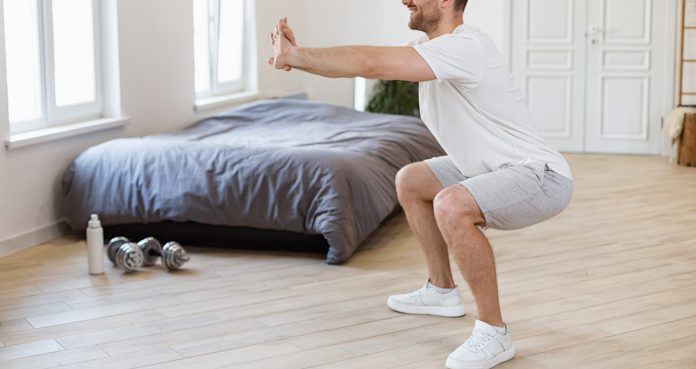Tag: #Quarantine

Top 5 Tips For Keeping Up With Your Cardio Indoors
There are ways to keep up with your cardio while working out at home.
Cardio might not be the most appealing type of exercise in the world, but it’s an important part of a healthy and well-rounded exercise routine. Keeping with your cardio can be a burden, but there are ways you can incorporate it into your daily workouts to make it more manageable.
If you’re still working from home, this is a great time to think about how you could incorporate exercise throughout the day since you no longer have going to the office taking up so much of your time.
Tip #1: The kettlebell is your friend.
Weight is your best friend when it comes to doing indoor cardio. Since you don’t have that much space to move around, the best trick is to utilize weights to force your body to break a sweat. The kettlebell is one of the best workout tools in this respect. You can do rapid kettlebell swings to get your heart rate up while standing in living room watching TV or on a Zoom call.
Doing twists while holding a kettlebell, when done rapidly, can also increase your cardio and help you lose weight! If you want to get serious about doing indoor cardio, definitely make sure you have one of these on hand, or an equivalent weighted tool you prefer like a medicine ball.
Tip #2: Sneak cardio into your strength training.
If you’re one of those people that absolutely dreads doing cardio, there are ways you can sneak cardio exercises into your strength training workouts. Simple modifications to common workouts are key. You could try doing five minutes of HIIT in between exercises as a way of getting cardio in while continuing to do whatever workout you normally do and enjoy.
Tip #3: Try jumping jacks, jump rope, and other ways of working out that don’t use equipment.
One of the biggest challenges of doing cardio at home is that — if you don’t have a home gym — you don’t have access to any of the fitness equipment like treadmills or rowing machines that make indoor cardio a breeze. You can still get cardio in at home with some tried and true classics like the jump rope.
Make a commitment to do fifteen minutes of jumping jacks before you start your day or before you go to bed. A jump rope is a cheap and easy way to do cardio in your house whenever you have the time. Remember, it’s the man that makes the workout, not the equipment.
Tip #4: High knees will help you break a sweat.
High knees are a cardio fundamental. It gets the blood pumping and you can do it pretty much anywhere. Plus, it burns fat in a pretty fast amount of time, so as long as you do it rapidly and with intensity you don’t even have to do it that long. Better yet, do it in small but intense bursts throughout the day to burn the most fat.
Tip #5: Don’t rely too much on HIIT for cardio, since it will disrupt your gains in strength training.
Lots of people choose HIIT as their weapon of choice when it comes to getting cardio in and it’s easy to see why. It’s quick, effective, and it gets the job done. But HIIT workouts can actually slim you down and decrease your gains from strength training since the exercises are designed to make your body more lean. If you’re trying to do cardio without sacrificing gains, make sure to not overdose on HIIT.

Try These Easy Exercises To Test Your Heart Health At Home
Selection of food that is good for the brain.
It can be a scary thought to visit a doctor these days, but there are still ways you can take charge of your fitness from home.
A lot of us suffer from vague anxieties about our health. Who here hasn’t had a headache and turned to WebMD to find out they have brain cancer or terminal encephalitis? Although the internet is riddled with fake news and bizarre fad diets and exercise trends that offer you too good to be true results, don’t panic: there are still ways you can take charge of your health that are based on science and are actually fairly simple.
Here are a few ways you can test your heart health from home without a trip to the doctor’s office.
How fast can you climb four flights of stairs?
A recent study done by the European Society of Cardiology found that being able to climb four flights of stairs in less than a minute is a clear indicator of good heart health.
“The stairs test is an easy way to check your heart health,” said study author Dr. Jesús Peteiro, a cardiologist at University Hospital A Coruña, Spain. “If it takes you more than one-and-a-half minutes to ascend four flights of stairs, your health is sub-optimal, and it would be a good idea to consult a doctor.”
Patients who were asked to climb four flights of stairs in under a minute and were unable to do so were far more likely to have undiagnosed coronary artery disease. If you have stairs in your house, this is a great and easy way to quickly test if your heart is relatively healthy. If you’re not able to complete this exercise, it may be a sign that something is up. However, there are many other ways you can measure your heart health from home.
Invest in an at-home blood pressure cuff or pulse monitor.
These are tools used by doctors to gather valuable metrics on the health of your heart that you can easily have in your own home. Blood pressure cuffs and pulse monitors can be used to check your heart rate and pulse before and after you work out. This can help you figure out if you’re in the optimal range for your age, gender, and weight group or not. This is also even more accurate than the stair test because it provides you with actual diagnostic criteria to understand how your heart is working.
This is obviously most relevant for those of us who work out with heart disease, but everyone can benefit from learning more about how their workouts affect their bodies. You might be surprised that your blood pressure is higher after working out than you realized — 1 in 5 adults who have high blood pressure have no symptoms and would never know without a blood pressure cuff check.
Do you find yourself getting out of breath during aerobic exercises?
This probably comes as a surprise to no one but aerobic exercises are some of the best for improving your heart health. Aerobic exercises improve the circulation of blood through your body and directly reduce your blood pressure and heart rate.
Although not as specific as the stairs test, aerobic exercises can be a great general indicator of your heart health. For example, if you find yourself unexpectedly out of breath during light aerobic exercise, you may have an underlying heart condition. This is also true if you feel extremely tired out by a light amount of aerobic exercise — there may not be enough oxygen in your blood traveling to your muscles. This isn’t an indicator alone that something is wrong, but it is something to keep an eye on.
With these three tricks in your back pocket, it should be easy to keep track of your heart health from home. But they aren’t a substitute for a real doctor if you are showing signs of having heart problems, so do make an appointment to see your doctor if it seems like something is wrong.
